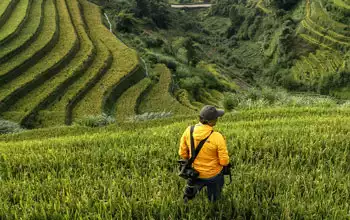Any traveller hoping to visit Japan knows that the country’s incredible cuisine is unlike any other. From delicious delicacies and hearty comfort food, and from high-end sushi restaurants to rustic street food stalls, there are so many different types of Japanese food to discover.
If you’re planning to take a Japan tour you’ll no doubt want to sample a taste of the country. But where to start? With our handy infographic and introduction into Japanese cuisine, you’ll soon be able to order delicious Japanese food like a professional traveller!

Noodles
Noodles are a staple part of Japanese cuisine. They are served hot, cold, in soups, or as a standalone meal, sometimes with a dipping sauce.
Are Noodles Good for You?
| Nutritional value | Kcal per 100g | Amino acids | Nutrients | Antioxidants |
| Ramen | 149 | N | Selenium (Se) , molybdenum (Mo) | Y |
| Soba | 99 | Y | Choline (C5H14NO+), thiamine (C12H17N4OS+) and riboflavin (C17H20N4O6) | Y |
| Shirataki | 12 | N | Calcium (Ca), iron (Fe) | N |
| Udon | 105 | N | Selenium (Se), molybdenum (Mo) | N |
| Sōmen | 127 | N | Selenium (Se), molybdenum (Mo) | N |
| Harusame | 345 | N | Calcium (Ca), iron (Fe) | N |
| Tokoroten | 2 | N | Iodine (I), molybdenum (Mo) | N |
Types of Noodles
- Ramen
- Ramen noodles are thin, pale yellow, and firm in texture, Ramen is also the name of a popular noodle soup
- In Japan, ramen is often called ‘gakusei ryōri’ meaning ‘student cuisine’
- Instant ramen was invented in Momofuku Ando in 1958
- The average Japanese person eats 45 packs of instant noodles per year
- Traveller’s tip – The tastiest ramen can be found at specialist ramen-ya restaurants
- Soba
- As opposed to ramen, which is made with wheat flour, soba is made from buckwheat
- Unlike ramen, soba contains all 8 essential amino acids
- Many people believe soba is preferably served cold as soaking them in a hot broth can change their consistency
- Shirataki
- These noodles have a gelatinous consistency and are mainly made of water
- These are incredibly low in calories and often marketed as ‘zero calories and zero carbs’
- Udon
- A flat noodle similar to Italian pasta but much thicker
- The origin of udon may go back to 1241 AD
- Sōmen
- Very thin noodles less than 1.3mm in diameter
- Usually served cold, they are a popular dish to help keep cool in the summer
- Harusame
- Harusame translates literally to ‘spring rain’
- These noodles are clear and made from potato or mung bean starch and water
- Tokoroten
- A jelly-like noodle made from seaweed
- These have been eaten in Japan for thousands of years
Sushi
Sushi is a delicious dish of seasoned and vinegared rice shari combined with seafood or vegetables as a topping neta.
The History of sushi
- Narezushi was an essential source of protein for the Japanese, it consisted of salted fish that was stored in fermented rice to keep the fish from spoiling.
- The word sushi comes from the word for ‘sour tasting’ as it has a sour savoury taste, what we now commonly refer to as the umami
- 0 AD to 14th century – The rice that stored the narezushi was discarded, but Japanese people found that adding vinegar to the rice negated the need for the fermentation process.
- 17th century – 19th century – People began to serve fresh fish with vinegared rice
- 19th century – Nigiri invented (some say perfected) by chef Hanaya Yohei
- 20th century – Sushi’s popularity around the world grows with the invention of the California Roll
- 1980 – 1995 – Norwegian businessman Bjørn Eirik Olsen introduces salmon into the Japanese and worldwide sushi market
WHAT A WASTE in Japan, it is considered very bad manners to waste soy sauce, so make sure to pour small amounts at a time into the dishes provided
Types of Sushi
- Nigiri
- Nigiri means ‘hand-pressed’ and is what we commonly think of when we say ‘sushi’
- Consists of an oblong mound of rice with a topping neta of usually seafood draped over the rice, sometimes bound with a thin strip of seaweed
- Maki
- Maki means ‘rolled’ and is formed by rolling in a bamboo mat.
- Maki is usually wrapped in seaweed, but omelette and cucumber are some of the other ingredients that can be used
- Chirashi
- Chirashi means ‘scattered’ and refers to a bowl of rice topped with raw fish and vegetables
- Chirashizushi is a popular dish eaten on Girls’ Day Hinamatsuri which occurs in Japan on March 3rd
- Oshi
- Oshizushi is similar to nigiri but is shaped onto a box shape with sharp edges
- Unlike nigiri though, the ingredients in Oshi are always either cooked or cured, and never raw
WHAT A MOUTHFUL In general, you are supposed to consume a piece of sushi in one bite so as not to destroy the chef’s beautiful work.
Portuguese Influences
Many Japanese dishes are influenced by Portugal. In the 16th Century, Portuguese trade ships reached Japan and introduced refined sugar, which heavily influenced what we now think of as traditional Japanese confectionery such as Castella sponge cakes kasutera and keiran somen (known in Portugal as angel hair).
TEMPURA! This Japanese staple food originated in Portugal! In 1543, sailors introduced peixinhos da horta, small pieces of vegetables fried in batter, which became Japanese tempura.
Other Japanese Food
- Miso Soup
- Along with white rice, miso soup is a common breakfast food in Japan
- The solid parts are eaten with chopsticks and the liquid is drunk from the bowl
- Sashimi
- Sashimi is very thin slices of raw meat and fish, traditionally served with a dipping sauce such as wasabi or soy sauce
- Sashimi is often the first course in a formal meal, but can be as part of a main served with rice or miso soup
- There are four types of cuts used to prepare sashimi, varying from 50mm to 2mm in thickness
- Rice dishes
- Like noodles, rice dishes make up a staple part of Japanese cuisine
- Popular rice dishes include katsu curry, donburi, and bento
TABLE MANNERS If you’re eating or drinking from a small bowl, you should move the bowl close to your mouth. Dishes served from large bowls should not be picked up.
Snacks & Street Food
- Takoyaki
- Fried balls of batter and diced octopus served with a savoury sauce and mayonnaise
- Invented in 1935 by a street vendor named Tomekichi Endo, and was inspired by a similar dish called akashiyaki
- Senbei
- Tasty rice crackers available in many shapes sizes and flavours from kimchi to chocolate
- They have been around since at least 737 AD!
- Yakitori
- Seasoned skewers of chicken on a bamboo stick, similar to a kebab
- There are many types of yakitori depending on the chicken meat used and the inclusion of vegetables
EAT UP! It is considered bad manners not to finish every item of food on your plate, even to the last grain of rice. Bear this in mind when serving yourself from a shared dish.
Desserts
- Mochi
- A delicious Japanese rice cake made from a type of glutinous rice mochigome
- In its origins in 300 BC – 300 AD, mochi was eaten exclusively by Emperors and nobles
- Dorayaki
- Dorayaki is made from two castella pancakes with a filling of sweet bean paste
- In some areas of Japan these are called Mikasa
- Internet meme bunny Oolong has balanced a dorayaki on his head
- Anmitsu
- A popular Japanese dessert similar to jelly and ice cream
- The jelly is made from agar and served with fruit juice, syrup, and pieces of fruit
REWIND! After finishing a meal, you should try to return the dishes to how they were set out at the start of your meal, this include putting lids back on bowls and placing your chopsticks back into their holder
Drinks
- Sake
- Sake is a Japanese rice wine, but is made through a process more similar to producing beer
- In Japanese, sake is generic the word for liquor, the sake that English speakers refer to is called nihonshu
- Green tea
- Green tea is a popular and refreshing beverage drunk commonly across Japan, China and the rest of the world.
- Japanese green teas are produced by steaming rather than firing the leaves
- In Japan, green tea is the only tea that is commercially produced, Japan does not produce any black tea.
It’s very rude to start drinking until everyone at your table also has a drink and is ready to raise their glasses for a toast, which is usually Kampai
If you’re still hungry for more, check out our other articles related to Japanese food including the best places to eat sushi in Japan and the top five dishes to try in Japan.
 Book an escorted tour to Japan with the UK’s leading Asia Experts, Wendy Wu Tours. Alternatively, work with our tailormade team to create your dream Japan holiday. Whichever you choose, we can guarantee you an unforgettable trip.
Book an escorted tour to Japan with the UK’s leading Asia Experts, Wendy Wu Tours. Alternatively, work with our tailormade team to create your dream Japan holiday. Whichever you choose, we can guarantee you an unforgettable trip.
We also have tours to Southeast Asia, China, India and South America.





















